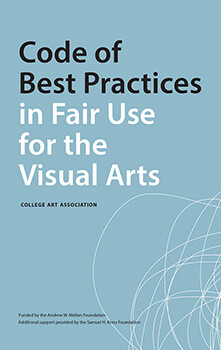Out now
The College Art Association (CAA) has published the Code of Best Practices in Fair Use for the Visual Arts, a set of principles addressing best practices in the fair use of copyrighted materials based on a consensus of opinion developed through discussions with visual-arts professionals. It will be a vital resource for all those working in the field, including artists, art historians, museum professionals, and editors. Initiated by CAA in 2012, the multi-year effort has been led by Peter Jaszi and Patricia Aufderheide, professors of law and communication studies respectively at American University and the leading experts on the development of codes for communities that make use of copyrighted materials in their professional practices.
The Code addresses many common situations in the visual arts by describing the relevance of fair use in five broad areas of the visual arts field:
– Analytic writing: When may scholars and other writers about art invoke fair use to quote, excerpt, or reproduce copyrighted works?
– Teaching about art: When may teachers invoke fair use in using copyrighted works to support formal instruction in a range of settings, including online and distance teaching?
– Making art: Under what circumstances may artists invoke fair use to incorporate copyrighted material into new artworks in any medium?
– Museum uses: When may museums and their staffs invoke fair use in using copyrighted works—including images and text as well as time-based and born-digital material—when organizing exhibitions, developing educational materials (within the museum and online), publishing catalogues, and other related activities?
– Online access to archival and special collections: When may such institutions and their staffs invoke fair use to create digital preservation copies and/or enable digital access to copyrighted materials in their collections?
In January 2014, CAA published Copyright, Permissions, and Fair Use among Visual Artists and the Academic and Museum Visual Arts Communities: An Issues Report, a summary of 100 interviews with art historians, artists, museum curators, editors, and publishers describing issues related to the use of third-party images in creative and scholarly work. The Issues Report, which revealed significant challenges in creating and disseminating new work due to actual and perceived limitations of copyright, was the subject of ten discussion groups held last summer throughout the country with visual arts professionals who deal with fair use and copyright issues on a daily basis. The Code is a result of this extensive research.
Co-author Patricia Aufderheide, university professor in the School of Communication at American University and Director of the Center for Media and Social Impact, said, “Codes of Best Practices have proven enormously successful in enabling members of other creative communities to do their work well and effectively. They allow individuals to make judgments knowing where they fall in relation to the thinking of their peers, and that lowers risk. Further, codes give museums, broadcasters, insurers, publishers, educational institutions, and their lawyers a new and valuable tool to use in making better, more reasonable assessments of risk.”
During CAA’s 103rd Annual Conference in New York (February 11–14, 2015), the principal investigators of this project and authors of the Code, Patricia Aufderheide and Peter Jaszi, will speak publicly with Judy Metro, Editor-in-Chief at the National Gallery of Art and chair of CAA’s Committee on Intellectual Property; Jeffrey Cunard, co-chair of CAA’s Task Force on Fair Use; and Christine Sundt, former editor of Visual Resources: An International Journal of Documentation and former CAA board member. The session will take place on Friday, February 13, from 12:30 to 2pm at the New York Hilton Midtown and is free and open to the public.
CAA’s Code of Best Practices in Fair Use for the Visual Arts is funded by the Andrew W. Mellon Foundation with additional support provided by the Samuel H. Kress Foundation.
About CAA
The College Art Association is dedicated to providing professional services and resources for artists, art historians, and students in the visual arts. CAA serves as an advocate and a resource for individuals and institutions nationally and internationally by offering forums to discuss the latest developments in the visual arts and art history through its annual conference, publications, exhibitions, website, and other programs, services, and events. CAA focuses on a wide range of advocacy issues, including education in the arts, freedom of expression, intellectual-property rights, cultural heritage and preservation, workforce topics in universities and museums, and access to networked information technologies. Representing its members’ professional needs since 1911, CAA is committed to the highest professional and ethical standards of scholarship, creativity, criticism, and teaching. Learn more about CAA here.
For more information please contact Janet Landay, CAA fair use initiative project manager, at
T +1 212 392 4420 or Hillary Bliss, CAA development and marketing manager, at T +1 212 392 4436.




